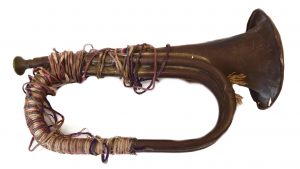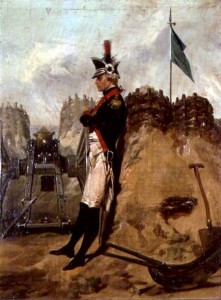On the morning of 21 April 2006, fifteen howitzer reports echoed through Arlington National Cemetery as LTG William Pelham Yarborough, USA-Ret., made his way to his final assignment aboard one of The Old Guard’s black caissons. LTG Yarborough’s last march included soldiers of the 3d Infantry (The Old Guard), the Army Band (Pershing’s Own), the 82d Airborne Division chorus, and representatives from Army Special Forces, including the commanders and colors of all Special Forces groups. To top it off, the Crown Prince of Thailand (a Special Forces Q-course graduate), his family, and their entourage paid their respects in person to the man who had been a good friend of the royal family for many years.

LTG Yarborough was born on 12 May 1912 in Seattle, Washington, to a military family. When, however, Yarborough began his career with the 57th Infantry, Philippine Scouts, in 1936 after his commission in the Infantry from West Point, few could have predicted his future accomplishments.

In 1940 he tested parachutes at Fort Benning and designed the parachutist boot, uniform, and qualification badge. By July 1942, he was in England helping MG Mark Clark plan the airborne assault of 2d Battalion, 509th Parachute Infantry, into Algeria during Operation Torch. The jump was the longest paratroop operation to date and provided many valuable lessons learned; subsequent airborne operations encountered far fewer difficulties, including the ones Yarborough participated in. He made an additional jump into North Africa onto the Youks les Bains airfield with the 509th. In July 1943 he jumped into Sicily with the 504th Parachute Infantry Regiment, 82d Airborne Division, and into southern France in August 1944 as commander of the 509th Parachute Infantry Battalion. In January 1945 he took command of the 473d Regimental Combat Team as it fought up the Ligurian Coast to Genoa and the French border as World War II came to an end.

In June 1945, Yarborough was appointed as Provost Marshal of Vienna, Austria, and surrounding areas where he instituted the “Four-men-in-a-Jeep” International Police program to create solidarity between the occupying powers and to quell civil disturbances, particularly those instigated by Soviet troops. In 1950, he attended the British Staff College at Camberly, and served on the faculty of the Army War College from 1952 until 1955. In 1956, the then COL Yarborough served in the first of many assignments in Asia as the Deputy Chief of the U.S. Military Advisory and Assistant Group to Cambodia.

He was then assigned to the 66th Military Intelligence Group in Stuttgart, West Germany, in 1958 and would later serve as the Assistant Deputy Chief of Staff for Special Operations in the Pentagon from 1966 to 1967, where he was also deeply involved in intelligence operations. In 1965, he was appointed Senior Member, UN Command Military Armistice Commission at Panmunjom, Korea, where he served as the chief spokesman and negotiator for the UN. In 1968 the Army assigned him as the commander of I Corps. The following year, he became the Chief of Staff and Deputy Commander-in-Chief, U.S. Army Pacific, where he directed a wide variety of activities, including planning joint operations and monitoring intelligence operations in the region. In 1971 LTG Yarborough retired from the Army and moved to Southern Pines, North Carolina, where he lived until his death on 6 December 2005. His greatest service to the nation, however, resulted from his role as the father of the modern Special Forces, the Green Berets, an assignment well suited to his personality.

In 1961, the Army assigned Yarborough to Fort Bragg, North Carolina, from Germany and appointed him as commander of the U.S. Army Special Warfare Center. Before his arrival, the center had been limited in resources and was almost unknown in the Army. For Yarborough, however, the assignment gave him the perfect opportunity in which to put his multi-faceted talents to use. His goal was, as Tom Clancy wrote in his book, Shadow Warriors: Inside the Special Forces, to train “fighting men who were far more skilled, imaginative, flexible, culturally sensitive, and resourceful” than both the then modeled OSS Special Forces and conventional soldiers. Yarborough and others saw that the United States needed to do more to combat the growing menace of grassroots communist movements around the world. To bring local villagers in remote lands into the U.S. camp, the new Special Forces soldiers were designed to work at the local level by providing a combination of military and civil services ranging from weapons training to medical care.

On 12 October 1961, President John F. Kennedy made a special visit to the center in order to see for himself the kind of work Special Forces could do. It was also on this visit that, in defiance of his superior’s wishes, Yarborough ordered the nonregulation green berets worn and in so doing, earned the right to wear them from the president himself. After Kennedy’s visit, Special Forces finally began to receive the attention it deserved, in much the same way that the OSS benefited from President Franklin Roosevelt’s attention during World War II. Years after he completed his tour there, Special Forces became one of the places to be for anyone—enlisted or officer—looking for advancement. The pageantry of 24 April reflected the most important aspect of LTG Yarborough’s character: variety.

To put it another way, he was a man who refused to be pigeon-holed in terms of interests or personality. Instead he resembled a modern-day renaissance man who possessed an interest in nearly everything and could move with ease between subjects. Yarborough’s level of comprehension of topics possessed a depth that often surprised all who knew him. His close friend, Jim Phillips, once sat stunned as he listened to the general speak for nearly two hours with an artist about paints and brushes. He was a man who could hold his own intellectually in any situation, from fine arts to the art of war. He was also a man of great foresight who predicted that many modern wars would not be fought as just pitched battles using conventional methods, but also with guerilla and insurgent tactics.

LTG Yarborough can be understood through more than his public accomplishments. Anyone visiting him during the last thirty years of his life at his home in Southern Pines would have been struck immediately by the house itself. Like his funeral, it spoke volumes about his personality and interests. From the outside, the house’s thick, stucco walls and surrounding pine trees made it resemble a German or Austrian chateaux nestled in the Alps. Perhaps it reminded him of his time as provost marshal in Vienna immediately after World War II. On the inside, the European motif continued, but it was counterbalanced by dozens of items brought back from his world travels, especially from the Far East. Gifts from the king of Thailand, Korean dignitaries, and African diplomats vied for space upon (and within) more traditional American and European pieces of furniture. For child and adult alike, the net effect was that he or she could wander for hours amid the strange and exotic and always be able to find something overlooked a previous time. In addition to the house’s contrast between the familiar and exotic, it also possessed a profound sense of quality and refinement that came from the high standards of craftsmanship that went into every chair, china plate, or item of military memorabilia.

LTG Yarborough lived his life with dignity and honor that could be seen even in the last days of his life. He produced many fine pieces of modern art and enjoyed the company of numerous friends and family. His mind and wit were also as sharp and toned as in his younger days as family friend, John Kupik, was told that a photograph he had taken of the general’s bust in the Airborne and Special Operations Museum would, “scare children.” If he can be faulted for one thing, it is that he never agreed with the increased use of computers because he thought they would take over the world one day. However, given his insightfulness on other matters, the world might do well to heed his advice.





